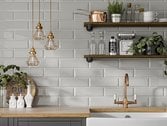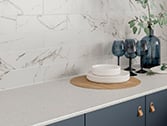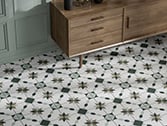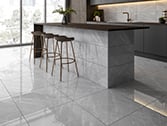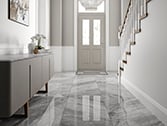How To Choose The Right Tile For Your Project


With so much choice available it can be hard to choose the right tile for your project. If you are thinking about using tiles in your next home decorating project but you’re not sure where to start, we’re here to help. We’ve put together some tips, tricks and inspiration to help you stop worrying about making the wrong decision, and instead find the perfect tiles for your next project.
Tiles can add a touch of style to any room, but it’s a big job, so you have a big decision to make when purchasing. With some careful planning and consideration, you can avoid costly mistakes and filter through the huge selection to find the perfect tile for you.
If you’re worried about choosing the wrong tiles, or aren’t sure where to start with choosing your tiles, follow our simple guide below.
Decide where your tiles are going to be laid
If you are choosing new tiles then you more than likely know which room you wish to tile. But the decisions don’t stop there. Different tiles are suitable for different areas. For example, some tiles are specially designed for walls, others are more suited for floors, and some are suitable for both.
Think about where you would like your tiles to be. On the practical side, would your wall benefit from tiles rather than paint, if it is in an area where it is likely to get scuffed?


Tip: If you are using wall tiles, remember to fix a door stop or buffer behind doors to prevent any damage.
On the aesthetic side, what effect are you aiming to create? Tiles can be used to create the illusion of a bigger room, or you may want something different and creative. If you’re unsure which style you are going for, we recommend taking a look at our Instagram or Pinterest for some inspiration from other customer projects.
If you are aiming for a consistent and harmonious look, you may wish to use the same tile on the walls and floor for consistency.
Tip: Order tile samples from our product pages and place them in the areas you think you would like to tile. Leave the samples there for about a week to get a feel for how they will look and whether you like them in those positions.
Choose your colours and textures
The colours and textures you use can greatly adjust the style of a room, so this decision is very much down to personal taste.
You may already have a colour scheme or ‘look’ in mind for your project, but if not then we have some tips to get you started.


- White - if you are looking for a crisp and clean feel, or to make your room light and airy; white is always a good option. They also help to make a small room look bigger, and it’s easy to find different coloured accessories to match.
- Neutrals and natural stone tiles - cream, beige and natural stone tiles can have a calming effect and bring a relaxed feeling to your home. With earthy tones, they are often a timeless choice and are easy to match with soft furnishings and accessories.
- Dark grey or black - darker tiles certainly add a more dramatic yet luxurious look to a room. They are also good for busy rooms, as they hide dirt and marks well.
- Light grey - similar to white, they tend to open up a room so are a popular choice for smaller rooms. Grey tiles also work well with pops of colour for an interesting contrast.
- Metallic or glass - for a unique and more glamorous look. Glass tiles add a touch of opulence and the reflections help to open up a room.
- Coloured - allow your style and personality to shine through with colourful or patterned tiles. Richer colours will add depth and drama, whilst brighter colours tend to make a room appear more open.


Also think about the colour of the grout you will pair with your tiles too. For a seamless effect, opt for a grout that matches or is as close to the tile colour as possible. Or for a finish that will stand out, opt for a coloured or darker grout for contrast.
Choose the size and scale
Despite initially sometimes being overlooked, the size and scale of the tiles you choose can really make a difference within a room.
Regarding proportions, as a rule of thumb, stick to larger tiles on the floor and smaller tiles on the wall. It also looks smart if you use the same sized tiles on both the wall and floor. Obviously there are no set rules , but we find these sizes give the best results.
To make a room appear larger, large format tiles are a great option as they make the surface space appear bigger. You can read more about large format tiles in our previous blog post.


If you are tiling an uneven surface, then smaller sizes or mosaic tiles will provide a better fit and finish.
We have a huge range of tiles, suitable for any room or style that you have in mind. If you are still too spoilt for choice, you can use our tile finder to help discover the perfect tiles for your project.
Decide on tile material
At a general level, the choice between tile materials lies between man-made tiles and natural stone tiles. But there is so much choice within these categories, so it’s good to know the differences and qualities between them.
If you are looking for a specific colour or texture, then man-made tiles would be a good option for you. There is also a really wide variety of man-made tiles and generally they are more affordable than natural tiles.
Natural stone tiles provide a unique and individual look, as no two tiles will ever be the same. Therefore, if you are not concerned about creating a uniformed and consistent finish, with a natural feel, then they are definitely worth considering.
We have a huge selection of both tile materials, so we will break them down even further below…
Man-made tiles
Ceramic tiles
Ceramic tiles are both affordable and low maintenance, making them one of the most popular types of tile on the market.
These tiles are easy to cut, fix and are waterproof once grouting has been added, with no need to seal the tiles.
As mentioned, there is a huge variety and wide range of ceramic man-made tiles. If you like the look of natural stone tiles, but don’t have the patience for the aftercare or maybe they are slightly out of budget; there are ceramic alternatives which have been made to mimic the look of natural tiles.


Porcelain Tiles
Due to the manufacturing process, porcelain tiles are known for their strength and durability. Naturally, they are less porous and more water resistant than ceramic tiles, which makes them a great choice for areas where there will be moisture, for example bathrooms and kitchens.
Known for strength and durability, porcelain tiles are available in a range of stone effects that will look great in any room. Plus you can choose from satin or matt finishes.
They can be glazed or unglazed, but unglazed will still require sealing and regular cleaning.
Natural Stone Tiles
Travertine


One of the most popular natural stone tile ranges, featuring warm earthy colours including cream, ivory and white.
Although a very heavy stone, travertine tiles can be prone to chipping. Also due to the porous nature of the stone, it can be prone to stains. Therefore, these tiles lend themselves to walls (not including splashbacks) and you should be prepared to care for them correctly by regularly cleaning and sealing them.
You can find out more about the characteristics of travertine tiles in our previous blog post.
A timeless tile with naturally occurring unique markings and a sleek polished finish.


A timeless tile with naturally occurring unique markings and a sleek polished finish.
Marble makes for a very durable tile, however they can be very slippy when wet, so they may be best placed in rooms with no moisture. They should be sealed both before and after fixing, then polished with a gloss finish.
For more information on the characteristics of marble tiles, head to our previous blog post.
Typically presenting a variety of grey, gold and brown hues, limestone adds a rustic farmhouse feel to your home. Again, Limestone will need careful maintenance to ensure the quality withstands over time.


Patterned or plain?
Once you have considered the practical side of the tiles you require, this is where your personality and style can really come into play!
If you’re quite adventurous when it comes to decorating, and like your eclectic style to show in your home, you may opt for some uniquely patterned tiles.
Patterned tiles are great as a feature, for example as a splashback or on the floor in a small room. However, they are just as effective in a larger room where you can showcase a larger geometric style design and take advantage of the space available.


For a more classic and minimalistic look, plain tiles may be better suited for your home. Although just because they are plain, they don't need to be boring! You can still experiment with textures and finishes, or lay tiles in interesting patterns. Learn more about tile laying patterns in one of our informative guides.


Don’t forget the extras
Hopefully, after following these steps you will now have a good idea of the perfect tile for your project. This means that you should now think about what you will need to lay, finish and maintain your chosen tiles to keep them looking like new.
A high quality tile adhesive is essential for securing tiles to the walls and floor. Take a look at which adhesive is best for the area you are tiling and ensure it is compatible with your chosen tiles.
If you are using a porous tile, you will also need a suitable sealant to prevent any staining and damage.
To create a professional finish, you will also need grout to fill between the gaps of tiles. As mentioned above, you will need to decide on your preferred grout colour to match your tiles and provide the best final look to showcase your decorating vision.







